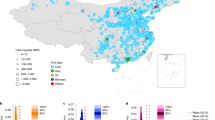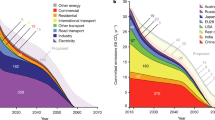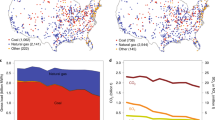Abstract
There are more than 30,000 biomass- and fossil-fuel-burning power plants now operating worldwide, reflecting a tremendously diverse infrastructure, which ranges in capacity from less than a megawatt to more than a gigawatt. In 2010, 68.7% of electricity generated globally came from these power plants, compared with 64.2% in 1990. Although the electricity generated by this infrastructure is vital to economic activity worldwide, it also produces more CO2 and air pollutant emissions than infrastructure from any other industrial sector. Here, we assess fuel- and region-specific opportunities for reducing undesirable air pollutant emissions using a newly developed emission dataset at the level of individual generating units. For example, we find that retiring or installing emission control technologies on units representing 0.8% of the global coal-fired power plant capacity could reduce levels of PM2.5 emissions by 7.7–14.2%. In India and China, retiring coal-fired plants representing 1.8% and 0.8% of total capacity can reduce total PM2.5 emissions from coal-fired plants by 13.2% and 16.0%, respectively. Our results therefore suggest that policies targeting a relatively small number of ‘super-polluting’ units could substantially reduce pollutant emissions and thus the related impacts on both human health and global climate.
This is a preview of subscription content, access via your institution
Access options
Access Nature and 54 other Nature Portfolio journals
Get Nature+, our best-value online-access subscription
$29.99 / 30 days
cancel any time
Subscribe to this journal
Receive 12 digital issues and online access to articles
$119.00 per year
only $9.92 per issue
Buy this article
- Purchase on Springer Link
- Instant access to full article PDF
Prices may be subject to local taxes which are calculated during checkout





Similar content being viewed by others
References
Energy Statistics and Balances of OECD Countries, 1990–2010 (International Energy Agency, Paris, 2012).
Energy Statistics and Balances of Non-OECD Countries, 1990–2010 (International Energy Agency, Paris, 2012).
Chen, S. T., Kuo, H. I. & Chen, C. C. The relationship between GDP and electricity consumption in 10 Asian countries. Energy Policy 35, 2611–2621 (2007).
Chan, C. K. & Yao, X. Air pollution in mega cities in China. Atmos. Environ. 42, 1–42 (2008).
Yoo, S. H. & Lee, J. S. Electricity consumption and economic growth: a cross-country analysis. Energy Policy 38, 622–625 (2010).
Liu, F. et al. High-resolution inventory of technologies, activities, and emissions of coal-fired power plants in China from 1990 to 2010. Atmos. Chem. Phys. 15, 13299–13317 (2015).
Zhao, Y. et al. Primary air pollutant emissions of coal-fired power plants in China: current status and future prediction. Atmos. Environ. 42, 8442–8452 (2008).
Ummel, K. CARMA Revisited: an Updated Database of Carbon Dioxide Emissions From Power Plants Worldwide Center for Global Development Working Paper 304 (2012).
Lu, Z. & Streets, D. G. Increase in NO x emissions from Indian thermal power plants during 1996–2010: unit-based inventories and multisatellite observations. Environ. Sci. Technol. 46, 7463–7470 (2012).
Lu, Z., Streets, D. G., de Foy, B. & Krotkov, N. A. Ozone monitoring instrument observations of interannual increases in SO2 emissions from Indian coal-fired power plants during 2005–2012. Environ. Sci. Technol. 47, 13993–14000 (2013).
Emission Database for GlobalAtmospheric Research (EDGAR) v. 4.3.1 (EC-JRC/PBL, European Commission, Joint Research Centre (JRC)/Netherlands Environmental Assessment Agency (PBL), accessed on 19 August 2017); http://edgar.jrc.ec.europa.eu/overview.php?v=431
Crippa, M. et al. Forty years of improvements in European air quality: regional policy-industry interactions with global impacts. Atmos. Chem. Phys. 16, 3825–3841 (2016).
Klimont, Z. et al. Global anthropogenic emissions of particulate matter including black carbon. Atmos. Chem. Phys. 17, 8681–8723 (2017).
Unger, N., Shindell, D. T. & Wang, J. S. Climate forcing by the on-road transportation and power generation sectors. Atmos. Environ. 43, 3077–3085 (2009).
Zhang, Q., He, K. & Huo, H. Cleaning China’s air. Nature 484, 161–162 (2012).
Burnett, R. T. et al. An integrated risk function for estimating the global burden of disease attributable to ambient fine particulate matter exposure. Environ. Health Persp. 122, 397-403 (2014).
Markandya, A. & Wilkinson, P. Electricity generation and health. Lancet 370, 979–990 (2007).
Davis, S. J. & Socolow, R. H. Commitment accounting of CO2 emissions. Environ. Res. Lett. 9, 084018 (2014).
Kurokawa, J. et al. Emissions of air pollutants and greenhouse gases over Asian regions during 2000–2008: Regional Emission inventory in ASia (REAS) version 2. Atmos. Chem. Phys. 13, 11019–11058 (2013).
EMEP/CEIP 2014 Present State of Emission Data (European Monitoring and Evaluation Programme (EMEP), accessed on 15 December 2015); http://www.emep.int/
Air Pollution Emissions Trends Data (Environmental Protection Agency (EPA), accessed on 15 December 2015); https://www.epa.gov/air-emissions-inventories/air-pollutant-emissions-trends-data
The National Pollutant Release Inventory (NPRI) (Environment Canada, accessed on 15 December 2015); https://www.ec.gc.ca/
Zhang, J. J. & Samet, J. M. Chinese haze versus Western smog: lessons learned. J. Thorac. Dis. 7, 3-13 (2015).
Verstraeten, W. W. et al. Rapid increases in tropospheric ozone production and export from China. Nat. Geosci. 8, 690–695 (2015).
Williams, J. H. et al. The technology path to deep greenhouse gas emissions cuts by 2050: the pivotal role of electricity. Science 335, 53–59 (2012).
Frost, G. J. D. et al. Effects of changing power plant NO x emissions on ozone in the eastern United States: Proof of concept. J. Geophys. Res. Atmos. 111, D12306 (2006).
Lelieveld, J., Evans, J. S., Fnais, M., Giannadaki, D. & Pozzer, A. The contribution of outdoor air pollution sources to premature mortality on a global scale. Nature 525, 367–371 (2015).
Shindell, D. & Faluvegi, G. The net climate impact of coal-fired power plant emissions. Atmos. Chem. Phys. 10, 3247–3260 (2010).
Pétron, G., Tans, P., Frost, G., Chao, D. & Trainer, M. High‐resolution emissions of CO2 from power generation in the USA. J. Geophys. Res. 113, G04008 (2008).
Gurney, K. R. et al. High resolution fossil fuel combustion CO2 emission fluxes for the United States. Environ. Sci. Technol. 43, 5535–5541 (2009).
Asefi‐Najafabady, S. et al. A multiyear, global gridded fossil fuel CO2 emission data product: evaluation and analysis of results. J. Geophys. Res. 119, 10213-10231 (2014).
Freudenburg, W. R. Privileged access, privileged accounts: toward a socially structured theory of resources and discourses. Soc. Forces 84, 89–114 (2005).
Grant, D., Jorgenson, A. & Longhofer, W. Targeting electricity’s extreme polluters to reduce energy-related CO2 emissions. J. Environ. Stud. Sci. 3, 376–380 (2013).
Jorgenson, A., Longhofer, W. & Grant, D. Disproportionality in power plants’ carbon emissions: a cross-national study. Sci. Rep. 6, 28661 (2016).
The Emissions & Generation Resource Integrated Database (eGRID) (US Environmental Protection Agency (USEPA), accessed on 15 December 2015); https://www.epa.gov/energy/egrid
World Electric Power Plant Database (WEPP) (Platts, 2014).
Davis, S. J., Caldeira, K. & Matthews, H. D. Future CO2 emissions and climate change from existing energy infrastructure. Science 329, 1330–1333 (2010).
Quadrelli, R. & Peterson, S. The energy–climate challenge: recent trends in CO2 emissions from fuel combustion. Energy Policy 35, 5938–5952 (2007).
Haszeldine, R. S. Carbon capture and storage: how green can black be? Science 325, 1647–1652 (2009).
Power Plant Carbon Dioxide Capture and Storage Projects (accessed on 15 August 2017); http://sequestration.mit.edu/tools/projects/index_capture.html
Smith, S. J. et al. Anthropogenic sulfur dioxide emissions: 1850–2005. Atmos. Chem. Phys. 11, 1101–1116 (2011).
Buonocore, J. J. et al. Health and climate benefits of different energy-efficiency and renewable energy choices. Nat. Clim. Change 6, 100–105 (2016).
Zhang, Q. et al. Transboundary health impacts of transported global air pollution and international trade. Nature 543, 705–709 (2017).
Unger, N. et al. Attribution of climate forcing to economic sectors. Proc. Natl Acad. Sci. USA 107, 3382–3387 (2010).
Work Plan of Fully Implementing Ultra-low Emissions and Energy Savings by Coal-fired Power Plants (in Chinese) (China’s Ministry of Environmental Protection, 2016); http://www.zhb.gov.cn/gkml/hbb/bwj/201512/t20151215_319170.htm
The Power Sector Development during the 13th Five-Year-Plan (in Chinese) (NationalEnergy Administration, 2016); http://www.gov.cn/xinwen/2016-11/07/content_5129638.htm
Wang, S. et al. Satellite measurements oversee China’s sulfur dioxide emission reductions from coal-fired power plants. Environ. Res. Lett. 10, 114015 (2015).
Liu, H. & Liang, D. A review of clean energy innovation and technology transfer in China. Renew. Sust. Energ. Rev. 18, 486–498 (2013).
Liu, Z. et al. A low-carbon road map for China. Nature 500, 143–145 (2013).
Seto, K. C. et al. Carbon lock–in: types, causes, and policy implications. Annu. Rev. Environ. Resour. 41, 425–452 (2016).
Ha-Duong, M., Grubb, M. J. & Hourcade, J. C. Influence of socioeconomic inertia and uncertainty on optimal CO2-emission abatement. Nature 390, 270–273 (1997).
Maruyama, N. & Eckelman, M. J. Long-term trends of electric efficiencies in electricity generation in developing countries. Energy Policy 37, 1678–1686 (2009).
Liu, Z. et al. Reduced carbon emission estimates from fossil fuel combustion and cement production in China. Nature 524, 335–338 (2015).
2006 IPCC Guidelines for National Greenhouse Gas Inventories (IPCC, 2006).
USEPA: Compilation of Air Pollutant Emission Factors (AP-42) (US Environmental Protection Agency (USEPA), accessed on 15 December 2015); http://www.epa.gov/ttn/chief/
Zhang, Q. et al. Asian emissions in 2006 for the NASA INTEX-B mission. Atmos. Chem. Phys. 9, 5131–5153 (2009).
Lu, Z. et al. Sulfur dioxide emissions in China and sulfur trends in East Asia since 2000. Atmos. Chem. Phys. 10, 6311–6331 (2010).
Streets, D. G., Wu, Y. & Chin, M. Two-decadal aerosol trends as a likely explanation of the global dimming/brightening transition. Geophys. Res. Lett. 33, L15806 (2006).
Lu, Z., Zhang, Q. & Streets, D. G. Sulfur dioxide and primary carbonaceous aerosol emissions in China and India, 1996–2010. Atmos. Chem. Phys. 11, 9839–9864 (2011).
Streets, D. G. et al. An inventory of gaseous and primary aerosol emissions in Asia in the year 2000. J. Geophys. Res. 108, D21 (2003).
Reddy, M. S. & Venkataraman, C. Inventory of aerosol and sulphur dioxide emissions from India. Part II: biomass combustion. Atmos. Environ. 36, 699–712 (2002).
Graus, W. H. J. & Worrell, E. Effects of SO2 and NO x control on energy-efficiency power generation. Energy Policy 35, 3898–3908 (2007).
Yao, W. Experiment on the SO2 removal efficiency of wet scrubbers. Environ. Protection 2, 11–13 (1989).
Zhu, F., Liu, D. & Wang, S. Overview of NO x emissions and control measures from thermal power plants. Environ. Protection 21, 40–41 (2009).
Zhao, Y., Wang, S., Nielsen, C. P., Li, X. & Hao, J. Establishment of a database of emissions factors for atmospheric pollutants from Chinese coal-fired power plants. Atmos. Environ. 44, 1515–1523 (2010).
EMEP/EEA Air Pollutant Emission Inventory Guidebook 2013: Technical Guidance to Prepare National Emission Inventories EEA Technical Report 12/2013 (EMEP/EEA, 2013).
Nazari, S. et al. Experimental determination and analysis of CO2, SO2 and NO x emissions factors in Iran’s thermal power plants. Energy 35, 2992–2998 (2010).
Srivastava, R. K., Hall, R. E., Khan, S., Culligan, K. & Lani, B. W. Nitrogen oxides emission control options for coal-fired electric utility boilers. J. Air Waste Manage. Assoc. 55, 1367–1388 (2005).
Lei, Y., Zhang, Q., He, K. B. & Streets, D. G. Primary anthropogenic aerosol emission trends for China, 1990–2005. Atmos. Chem. Phys. 11, 931–954 (2011).
Klimont, Z. et al. Modelling Particulate Emissions in Europe: a Framework to Estimate Reduction Potential and Control Costs IIASA interim report (IIASA, 2002).
Amann, M. et al. Cost-effective control of air quality and greenhouse gases in Europe: modeling and policy applications. Environ. Modell. Softw. 26, 1489–1501 (2011).
Acknowledgements
This work was supported by the National Science Foundation of China (41625020), China’s National Basic Research Program (2014CB441301), and the National Key R&D program (2016YFC0201506). Q.Z. and K.H. are supported by the Collaborative Innovation Center for Regional Environmental Quality. D.G. acknowledges support from the ational Science Foundation of China (41629051). The India component of the work was funded by the Office of Biological and Environmental Research in the US Department of Energy, Office of Science, for which Z.L. and D.G.S. are grateful to Ashley Williamson and Bob Vallario.
Author information
Authors and Affiliations
Contributions
Q.Z. designed the research. D.T., F.L., B.Z., G.G., T.X., M.L. and C.H. performed the research. Z.L. and D.G.S. provided data for Indian power plants. D.T., S.J.D. and Q.Z. interpreted data. D.T., S.J.D. and Q.Z. wrote the paper with inputs from all co-authors.
Corresponding authors
Ethics declarations
Competing interests
The authors declare no competing financial interests.
Additional information
Publisher’s note: Springer Nature remains neutral with regard to jurisdictional claims in published maps and institutional affiliations.
Supplementary information
Supplementary Information
Supplementary Methods, Supplementary Figs. 1–8, Supplementary References.
Supplementary Tables
Supplementary Tables 1–7.
Rights and permissions
About this article
Cite this article
Tong, D., Zhang, Q., Davis, S.J. et al. Targeted emission reductions from global super-polluting power plant units. Nat Sustain 1, 59–68 (2018). https://doi.org/10.1038/s41893-017-0003-y
Received:
Accepted:
Published:
Issue Date:
DOI: https://doi.org/10.1038/s41893-017-0003-y
This article is cited by
-
Cost-effectiveness uncertainty may bias the decision of coal power transitions in China
Nature Communications (2024)
-
Integrated Study of Air Pollutant Emissions from Different Sources in Isfahan City of Iran
Water, Air, & Soil Pollution (2024)
-
More Power Generation, More Wheat Losses? Evidence from Wheat Productivity in North China
Environmental and Resource Economics (2024)
-
Potential reductions in fine particulate matter and premature mortality following implementation of air pollution controls on coal-fired power plants in India
Air Quality, Atmosphere & Health (2024)
-
MEIC-global-CO2: A new global CO2 emission inventory with highly-resolved source category and sub-country information
Science China Earth Sciences (2024)



